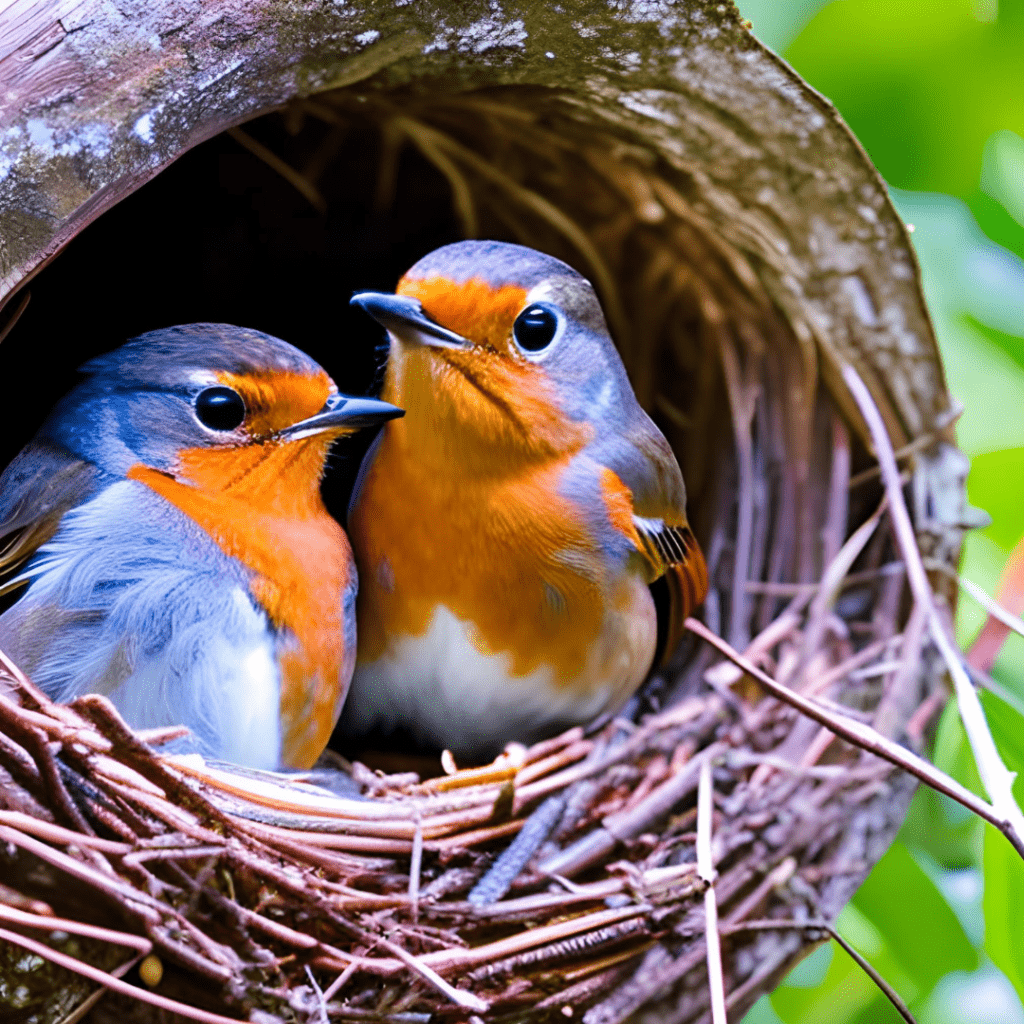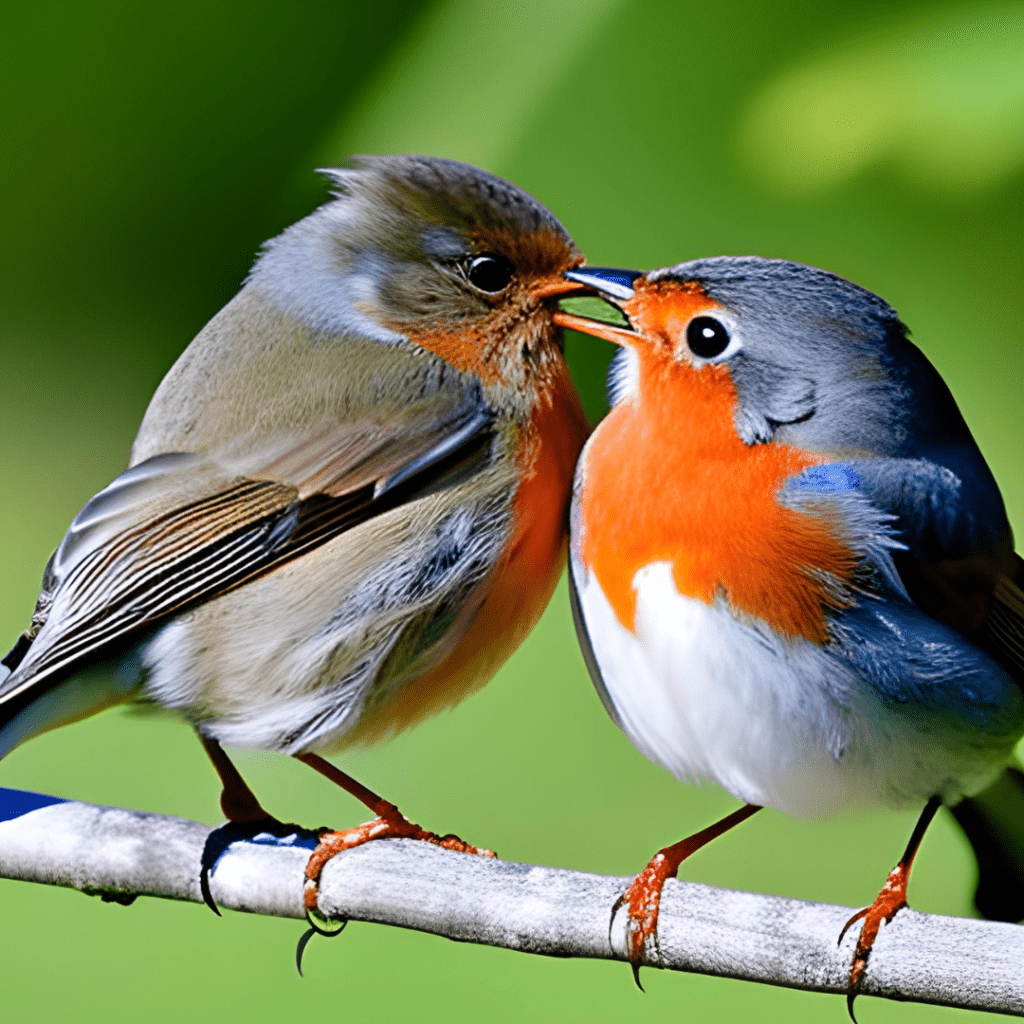Robins are a common sight in gardens, parks, and wooded areas across North America and Europe, delighting bird lovers with their beautiful songs and striking red breasts. As an ornithologist and birding blogger, I’m often asked questions about their fascinating behaviors, including their mating habits. In this blog post, we’ll dive into the world of robins and investigate the intriguing question: Do robins mate for life? So grab a cup of tea, sit back, and let’s explore the world of these delightful birds together!

So let's answer the question! Do Robins Mate for Life?
No, robins do not mate for life. They form pair bonds during the breeding season, which are usually short-term and may change between or even within breeding seasons. Factors such as territory quality, breeding success, and external pressures can influence their mating patterns, which have evolved to ensure the survival and reproductive success of the species.
Mating Behaviors of Robins
Before we answer the big question, let’s first take a closer look at the mating process of robins.
Overview of the mating process
Courtship: The mating season for robins typically begins in early spring. Males establish territories and serenade potential mates with their melodious songs. Females, drawn to the males’ displays, will then respond with a softer call. The pair may engage in several courtship displays, such as chasing and fluttering, before ultimately deciding to mate.
Nest building: Once a pair is formed, the male and female will work together to build a nest. While the male gathers materials, the female is responsible for constructing the nest. They usually choose a well-concealed spot in a tree or shrub.
Egg-laying and incubation: After the nest is built, the female will lay a clutch of 3-5 eggs, which she will incubate for about 12-14 days. During this time, the male will continue to sing and defend the territory, as well as provide food for the female.
Role of songs and displays for Robins
The male robin’s song plays a crucial role in attracting a mate. These vocalizations are complex and varied, allowing the female to assess the male’s fitness and territory quality. In addition to singing, males will also engage in physical displays, such as puffing out their red breasts and raising their tails, to catch the attention of potential mates.
Copulation and fertilization
Once a female has chosen her mate, the pair will copulate, often multiple times over a short period. After mating, the female will lay her eggs, and the fertilization process will begin.
Pair Bonding in Robins
Now that we have a basic understanding of the mating process, let’s explore the concept of pair bonding among robins.
Definition of pair bonding
Pair bonding refers to the formation of a close relationship between two individuals, typically of the opposite sex, which can involve cooperation in raising offspring, shared territory, and mutual grooming. In birds, pair bonding can range from short-term to lifelong relationships.
Duration of pair bonds in robins
Robins do form pair bonds, but they are generally not considered lifelong. These bonds usually last for a single breeding season, or in some cases, may persist through multiple seasons. However, it is important to note that robins are not strictly monogamous, and they may change mates between breeding seasons or even during a single season.

Factors influencing pair bond strength
Several factors can influence the strength of a pair bond in robins:
- Territory quality: A male with a high-quality territory may be more likely to maintain a strong pair bond with a female, as they both benefit from the resources available.
- Breeding success: Pairs that successfully raise offspring may be more likely to remain together for future breeding attempts.
- External factors: Predation, habitat loss, or disturbances can affect pair bond strength by causing one or both partners to abandon the territory or seek new mates.
Differences between pair bonding and mating for life
While pair bonding involves the formation of a close relationship between two individuals, mating for life implies a long-term commitment to a single mate. As mentioned earlier, robins form pair bonds, but they do not mate for life. Their relationships are typically short-term and may change between or even within breeding seasons.
How Do Robins Mate?
Robins have a unique and fascinating mating process that involves a series of behaviors and rituals to ensure successful reproduction. Let’s explore the key steps in the mating process of robins:
Courtship Rituals
Singing and territorial displays: The mating process begins with male robins establishing territories and singing to attract females. Males use their songs to advertise their territory quality, fitness, and availability for mating. They may also engage in physical displays, such as puffing out their red breasts and raising their tails, to catch the attention of potential mates.
Female response: Interested females will respond to the male’s song with a softer call, signaling their receptiveness. The male and female may then engage in a series of courtship displays, including chasing, fluttering, and perching close to one another. These interactions help establish a connection between the pair and determine compatibility.
Nest Building and Mate Guarding
Nest building: Once a pair is formed, the male and female work together to build a nest. The male gathers materials such as twigs, leaves, and grass, while the female constructs the nest in a concealed spot in a tree or shrub. A well-built nest is crucial for the protection and incubation of the eggs.
Mate guarding: Throughout the nest-building and egg-laying stages, the male robin will guard the female to ensure she does not mate with other males. This behavior, known as mate guarding, helps to prevent extra-pair copulations and increases the chances that the male’s genes will be passed on to the offspring.
Copulation
Once the nest is built and the female is ready to lay her eggs, the pair will copulate. The male will mount the female, and they will briefly press their cloacas together, allowing the transfer of sperm from the male to the female. This process, called the “cloacal kiss,” typically lasts only a few seconds but may be repeated several times to ensure successful fertilization.
Egg Laying and Incubation
Following copulation, the female robin will lay a clutch of 3-5 eggs in the nest. She will then incubate the eggs for approximately 12-14 days, while the male continues to defend the territory and provide food for her. Once the eggs hatch, both parents will care for the chicks until they fledge and become independent.
In summary, the mating process of robins involves a series of intricate courtship rituals, nest building, mate guarding, copulation, and parental care. These behaviors have evolved to ensure the successful reproduction and survival of these charming birds.
Factors Influencing Mate Selection in Robins

Understanding the factors that drive mate selection in robins can help shed light on their mating patterns.
Territory and resources
Males with larger, resource-rich territories are often more attractive to females. High-quality territories provide better nesting sites and abundant food sources, which increase the chances of successful breeding and offspring survival.
Physical characteristics and plumage
Females may also choose mates based on physical characteristics, such as size, coloration, and overall health. Males with vibrant plumage or impressive displays are often considered more desirable.
Age and experience
Older, more experienced robins might have an advantage in attracting mates due to their ability to defend territories, find food, and successfully raise offspring.
Previous breeding success
Females may be more likely to choose males with a history of successful breeding, as this indicates good genes and the ability to provide for offspring.
Exceptions and Variations in Mating Patterns
Robins’ mating patterns are not always straightforward, and there can be exceptions and variations in their behaviors.
Situations leading to re-mating or multiple mates
Robins may re-mate or seek multiple mates under certain circumstances, such as:
- Loss of a mate: If one partner dies or disappears, the remaining robin will likely seek a new mate to continue breeding.
- Failed breeding attempt: If a nesting attempt fails due to predation or other factors, robins may seek new mates to increase their chances of success in future breeding attempts.
Extra-pair paternity
While robins form pair bonds, they may also engage in extra-pair copulations, meaning they mate with individuals outside of their pair. This can result in mixed paternity within a single clutch of eggs. Extra-pair paternity is relatively common in robins and may provide genetic benefits for the offspring.
Instances of long-term pair bonds
Although most robin pair bonds are short-term, there have been instances of long-term pair bonds. These cases are rare and usually occur when both partners have a history of successful breeding and are able to maintain a high-quality territory.
Implications of Robins' Mating Behaviors on Survival and Reproduction
Effects on reproductive success
Mating behaviors, such as mate selection and pair bonding, can influence reproductive success by affecting the quality of the territory, the availability of resources, and the genetic diversity of the offspring. By selecting high-quality mates and territories, robins increase their chances of successfully raising offspring and passing on their genes to the next generation.
Influence on population dynamics
Robins’ mating behaviors can also impact population dynamics. The ability to form new pair bonds or engage in extra-pair copulations ensures genetic diversity and helps maintain a stable population size.
Role in shaping robin behavior and evolution
Mating behaviors are shaped by evolutionary pressures, and in turn, these behaviors can influence the evolution of the species. As robins adapt to changing environments, their mating patterns may also evolve to ensure the continued success of the species.
Conclusion
In conclusion, while robins form pair bonds during the breeding season, they generally do not mate for life. Their relationships are often short-term and can be influenced by factors such as territory quality, breeding success, and external pressures. The complexity of their mating patterns is a result of evolutionary pressures, which helps ensure the survival and reproductive success of the species.
Understanding the mating behaviors of robins is not only fascinating for bird enthusiasts but also crucial for conservation efforts. By comprehending the factors that drive their mating patterns and their implications on survival and reproduction, we can better protect these charming birds and their habitats.
So, the next time you spot a pair of robins in your backyard, take a moment to appreciate the intricate dance of courtship, pair bonding, and mate selection unfolding before your eyes. And remember, the world of robins is full of surprises, making every bird-watching experience a delightful adventure. Happy birding!=

James has always been an avid outdoorsman. Since a kid, he kept a journal of all the different birds and species he saw. Now he wants to share his passion with other birders with Happy Birding!
